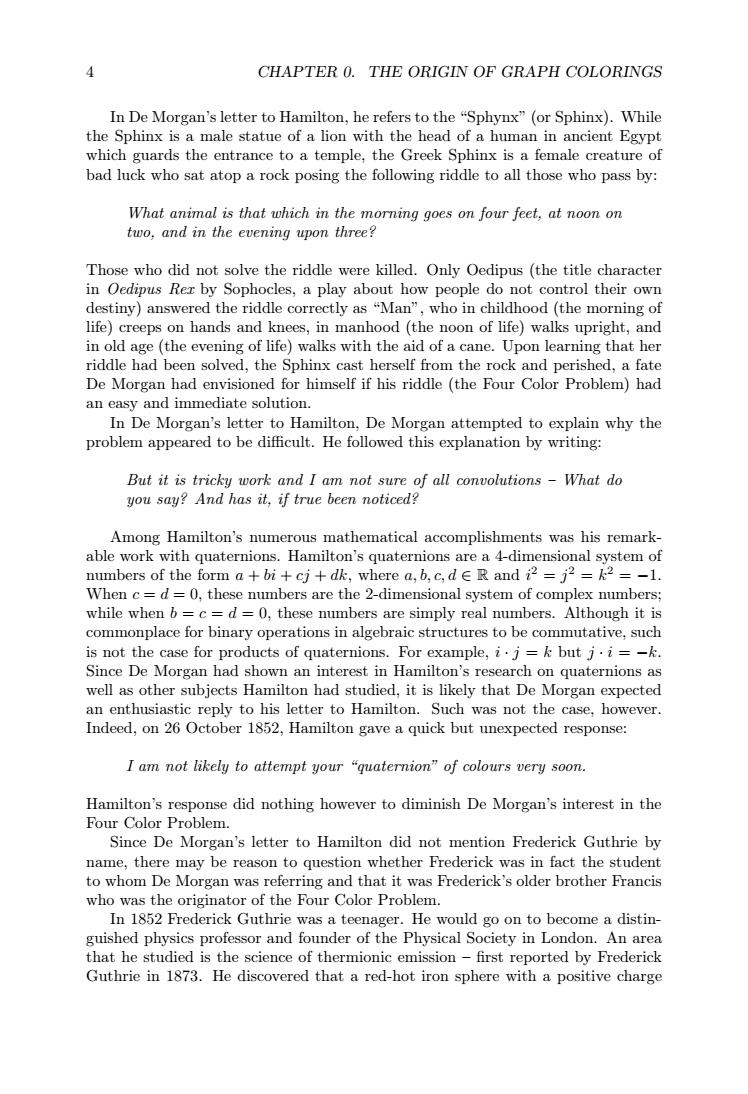正在加载图片...

CHAPTER 0.THE ORIGIN OF GRAPH COLORINGSIn De Morgan's lettertoHamilton, he refersto the"Sphynx"(or Sphinx).Whilethe Sphinx is a male statue of a lion with the head of a human in ancient Egyptwhich guards the entrance to a temple, the Greek Sphinx is a female creature ofbad luck who sat atop a rock posing the following riddle to all those who pass by:What animal is that which in the morning goes on four fet, at noon ontwo, and in the evening upon three?Thoswho did not solve the riddle were killed. Only Oedipus (the titcharactein Oedipus Rer by Sophocles, a play about how people do not control their owndestiny) answered the riddle corectly as"Man'whoin childhood (the morning oflife) creeps on hands and knees, in manhood (thenoon of life) walks upright, andin old age (the evening of life) walks with the aid of a cane. Upon learning that herriddle had been solved, the Sphinx cast herself from the rock and perished, a fateDe Morgan had envisioned for himselfifhis riddle (the Four Color Problem) hadan easy and immediate solution.In De Morgan's letter to Hamilton, De Morgan attempted to explain why theproblem appeared to be difficult. He followed this explanation by writing:But it is tricky work and I am not sure of all convolutions-What doyou say? And has it, if true been noticed?Among Hamilton's numerousmathematical accomplishments was his remarkable work with quaternions.Hamilton's quaternions are a 4-dimensional svstem ofnumbers of the form a + bi + cj + dk, where a,b,c, d e R and ,? = j2-2-When c- 0.these numbers are the 2-dimensional system of complex nunberswhile when b= d - 0, these numbers are simply real numbers. Although it isnonplace for binary operations in algebraic structures to be commutative, suchis not the case for products of quaternions. For example, i. j = k but j -i - -h.Since De Morgan had shown an interest in Hamilton's research on quaternions aswell asother subjects Hamilton had studied itislikely that De Morgan expectedI enthusiastic reply to his letter to Hamilton.Such was not the case, however.Indeed, on 26 October 1852, Hamilton gave a quick but unexpected response:I am not likely to attempt your “quaternion" of colours very soon.Hamilton's response did nothing however to diminish De Morgan's interest in theFourColorProbleSince De Morgan's letter to Hamilton did not mention Frederick Guthrie byname, there may bereason to question whether Frederick was in fact the studento whom De Morgan was referring and that it was Frederick's older brother Franciswhowasthe originatorof theFour Color ProblemIn 1852Frederick Guthrie was a teenager.He would go on to become a distinguished physics professor and founder of the Physical Society in Londor.Anareathat he studied is the scienceof thermionic emission-firstreported byFrederickGuthrie in 1873. He discovered that a red-hot iron sphere with a positive charge4 CHAPTER 0. THE ORIGIN OF GRAPH COLORINGS In De Morgan’s letter to Hamilton, he refers to the “Sphynx” (or Sphinx). While the Sphinx is a male statue of a lion with the head of a human in ancient Egypt which guards the entrance to a temple, the Greek Sphinx is a female creature of bad luck who sat atop a rock posing the following riddle to all those who pass by: What animal is that which in the morning goes on four feet, at noon on two, and in the evening upon three? Those who did not solve the riddle were killed. Only Oedipus (the title character in Oedipus Rex by Sophocles, a play about how people do not control their own destiny) answered the riddle correctly as “Man”, who in childhood (the morning of life) creeps on hands and knees, in manhood (the noon of life) walks upright, and in old age (the evening of life) walks with the aid of a cane. Upon learning that her riddle had been solved, the Sphinx cast herself from the rock and perished, a fate De Morgan had envisioned for himself if his riddle (the Four Color Problem) had an easy and immediate solution. In De Morgan’s letter to Hamilton, De Morgan attempted to explain why the problem appeared to be difficult. He followed this explanation by writing: But it is tricky work and I am not sure of all convolutions – What do you say? And has it, if true been noticed? Among Hamilton’s numerous mathematical accomplishments was his remarkable work with quaternions. Hamilton’s quaternions are a 4-dimensional system of numbers of the form a + bi + cj + dk, where a, b, c, d ∈ R and i 2 = j 2 = k 2 = −1. When c = d = 0, these numbers are the 2-dimensional system of complex numbers; while when b = c = d = 0, these numbers are simply real numbers. Although it is commonplace for binary operations in algebraic structures to be commutative, such is not the case for products of quaternions. For example, i · j = k but j · i = −k. Since De Morgan had shown an interest in Hamilton’s research on quaternions as well as other subjects Hamilton had studied, it is likely that De Morgan expected an enthusiastic reply to his letter to Hamilton. Such was not the case, however. Indeed, on 26 October 1852, Hamilton gave a quick but unexpected response: I am not likely to attempt your “quaternion” of colours very soon. Hamilton’s response did nothing however to diminish De Morgan’s interest in the Four Color Problem. Since De Morgan’s letter to Hamilton did not mention Frederick Guthrie by name, there may be reason to question whether Frederick was in fact the student to whom De Morgan was referring and that it was Frederick’s older brother Francis who was the originator of the Four Color Problem. In 1852 Frederick Guthrie was a teenager. He would go on to become a distinguished physics professor and founder of the Physical Society in London. An area that he studied is the science of thermionic emission – first reported by Frederick Guthrie in 1873. He discovered that a red-hot iron sphere with a positive charge